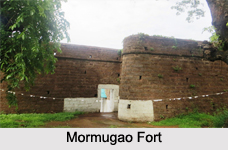 Mormugao Fort is an Indian regional monument located in the north western part of the state of Goa. More specifically, this coastal fort is situated to the north to Vasco Da Gama town and just south of Murmogao Port. This fort stands as a first-rate example of tough fortification. This fortress is considered to be one of tourism product of Goa. This historically significant fort provides an amazing bird"s eye view of the surroundings of the Mormugao Fort. The Mormugao is considered to be an outstanding specimen of fort architecture in Goa.
Mormugao Fort is an Indian regional monument located in the north western part of the state of Goa. More specifically, this coastal fort is situated to the north to Vasco Da Gama town and just south of Murmogao Port. This fort stands as a first-rate example of tough fortification. This fortress is considered to be one of tourism product of Goa. This historically significant fort provides an amazing bird"s eye view of the surroundings of the Mormugao Fort. The Mormugao is considered to be an outstanding specimen of fort architecture in Goa.
History of Mormugao Fort
The Mormugao fort was quite famous for being an important fortress on the western coast. The coastal region occupied by the Portuguese was of utmost importance to them, as trade ships comprised their most important source of income. Thus, the Murmogao Fort was consequently planned to be constructed. It ensured the security and safety of the valuable harbors and ports of Goa and also attaining complete control of them. In 1624, the Portuguese commenced the construction of this fort. However, during this time, the Portuguese were disturbed by attacks, which were launched by the Marathas. This prompted the then Viceroy of the Portuguese Empire to change their capital city from Old Goa to Margao. In 1703, the then viceroy moved into the Murmogao Fort and used this fort as his residence till the late 17th century. The Portuguese had again shifted their base back to Old Goa. During the early 18th century, the Marathas gained control of this fort. The Maratha then ruled over this fort for the next few years, until the Portuguese again won control over it.
Architectural Design of Mormugao Fort
During the rule of the Portuguese, the Mormugao fort was constructed following the Portuguese style of architecture. The Marathas under their control had changed the design of the fort, following the Hindu style of architecture. The church was beautifully designed with bricks and mud. The Mormugao fort in Goa covers a circumference area of almost 6 miles. This fort earlier had a tall fortification and five prisons. It had magazines, a chapel and quarters for the sentinel. There were 53 guns and a garrison inside the fort. It also has two big fountains called the Fonte de Malabar and the The Fonte de Santo. The Fonte de Malabar kept the imperial weapons and is said to have been dug from a gold mine. The Fonte de Santo Ignacio has a more unpretentious beginning in a sulphur mine. The fort has rich historical importance as priceless historical information is hidden in the inscriptions of its wall. It reads the names of the Catholic King, Dom Filippe, the third of this name reigning in Portugal, Dom Francisco da Gama, fourth Count of Vidigueira, Admiral of India, a member of His Majesty`s Council and a Gentleman of the royal household, being Viceroy for the second time. This fort is also adorned by a garden. This fort even today is guarding the mouth of its harbor. The bulwarks and bastions still stand strong in the Mormugao fort.
Other Places of Attraction near Mormugao Fort
The Varca beach is located near Mormugao fort. Here, a plethora of fishing boats is found.
Visiting Information
The summer season is generally considered to be the best time to plan a tour to Marmugao fort. Due to the uneven nature of the terrain on which the Marmugao fort is located, it is advised to visit this place during the daylight hours rather than at night. Marmugao fort has good transport availability. The nearest airport to Marmugao fort is Dabolim Airport in Goa. This airport is located at a distance of about 4 kilometers south of the city of Vasco Da Gama. Roads leading to Marmugao fort are motorable by cabs, buses, rickshaws and bikes.
Related Articles:
Forts in India
Forts of Goa
Anjediva Fort
Mormugao Fort
Corjuem Fort
Aguda Fort




